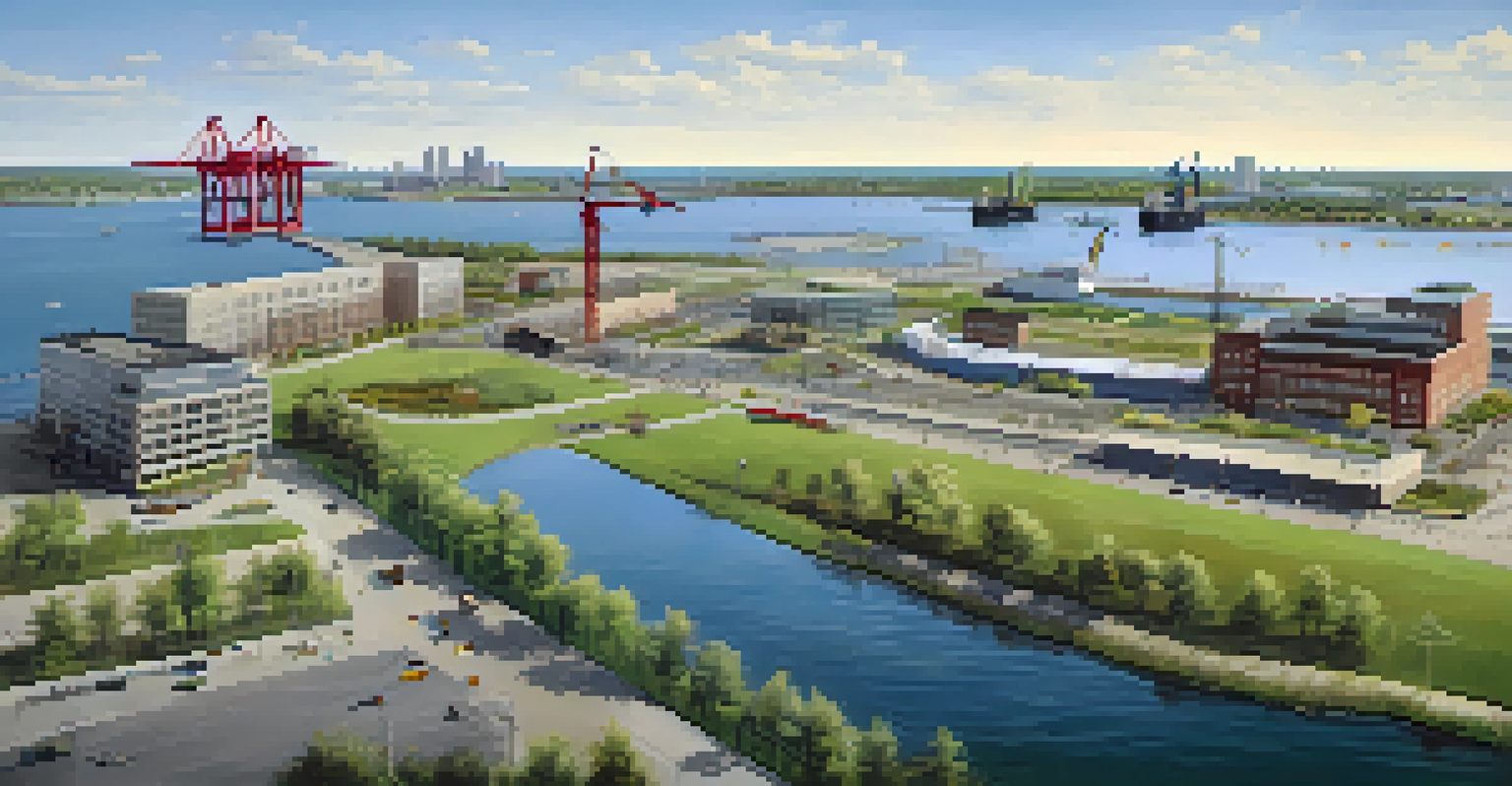Transportation and Infrastructure: Buffalo's Economic Backbone

The Historical Context of Buffalo’s Transportation Network
Buffalo’s transportation history dates back to its founding, where its strategic location on Lake Erie made it a vital hub for trade. The Erie Canal, completed in 1825, further cemented Buffalo’s importance by connecting the Great Lakes to the Atlantic Ocean. This historic waterway not only boosted local commerce but also attracted industries, leading to a population boom and economic growth.
Transportation is the backbone of the economy.
As the industrial revolution took hold, Buffalo evolved into a manufacturing powerhouse, with transportation infrastructure at its core. Railroads began to crisscross the city, enhancing freight movement and providing jobs to thousands. These developments set the stage for Buffalo's reputation as a bustling center for goods and services.
Today, remnants of this rich history can still be seen in Buffalo's extensive transportation networks, including highways, railroads, and shipping lanes. Understanding this historical context allows us to appreciate how far Buffalo has come and the role of transportation in its ongoing economic narrative.
Current Transportation Infrastructure: A Vital Economic Driver
Buffalo's transportation infrastructure continues to be a key driver of its economy. The city boasts a well-connected system that includes major highways like the I-90 and I-290, facilitating efficient travel for both people and goods. This accessibility is crucial for businesses that rely on timely deliveries and connectivity with regional markets.

In addition to roadways, the Buffalo Niagara International Airport serves as a gateway for air travel, supporting tourism and business travel alike. The airport’s growth reflects the city's commitment to enhancing its transportation options to attract new investments. Furthermore, the presence of railroads continues to play a significant role, particularly for freight transport, which supports local industries and job creation.
Buffalo's Rich Transportation History
Buffalo's strategic location and historical developments, like the Erie Canal and railroads, laid the groundwork for its economic growth.
Moreover, Buffalo's port facilities are essential for shipping goods across the Great Lakes and beyond. This combination of road, air, and water transport creates a robust ecosystem that empowers businesses and fosters economic diversification in the region.
The Role of Public Transportation in Buffalo’s Economy
Public transportation in Buffalo is more than just a means of getting from point A to point B; it's a crucial aspect of the local economy. The Niagara Frontier Transportation Authority (NFTA) operates buses and light rail services that connect residents to jobs, education, and essential services. This accessibility helps to lower transportation costs for individuals and families, allowing them to allocate resources elsewhere.
Investing in infrastructure is investing in our future.
Moreover, a reliable public transit system attracts businesses looking to establish themselves in areas with convenient access for employees and customers. When workers can easily reach their jobs, companies benefit from a larger talent pool. This dynamic encourages economic growth and community development, enhancing the overall quality of life in Buffalo.
Despite its importance, Buffalo's public transportation system faces challenges, including funding and maintenance issues. However, continued investment and strategic planning can improve service and expand coverage, ensuring that public transit remains a vital component of the city's economic backbone.
Infrastructure Investments: Future Opportunities for Growth
Investing in infrastructure is essential for Buffalo's future economic growth. Recent federal and state initiatives have allocated funds aimed at upgrading roads, bridges, and public transport systems. These investments provide an opportunity to modernize aging infrastructure, which can improve safety and efficiency for residents and businesses alike.
One significant project underway is the redevelopment of the Buffalo Outer Harbor, which aims to enhance transportation access while creating recreational spaces. This redevelopment not only boosts the local economy by attracting tourism but also supports job creation during construction and beyond. Such projects exemplify how targeted investments can yield long-term benefits.
Public Transport Fuels Economic Growth
Reliable public transportation connects residents to jobs and services, boosting the local economy and enhancing community development.
In addition, the push for sustainable transportation options, such as electric buses and bike lanes, reflects a growing awareness of environmental concerns. Embracing green infrastructure will not only improve urban mobility but also position Buffalo as a forward-thinking city that values sustainability alongside economic growth.
The Impact of Transportation on Local Businesses
Transportation infrastructure significantly impacts local businesses, shaping their operations and growth potential. Easy access to major highways and transport hubs allows companies to efficiently manage their supply chains, reducing delays and costs. For instance, a logistics company located near the Buffalo Niagara International Airport can expedite shipping processes, gaining a competitive edge in the market.
Moreover, businesses that rely on foot traffic, such as retail shops and restaurants, benefit from the accessibility provided by public transit. When residents can easily reach these establishments, it increases customer visits and, ultimately, sales. Consequently, a well-developed transportation network contributes directly to the profitability and viability of local businesses.
In contrast, inadequate transportation can hinder business growth, leading to lost opportunities and reduced economic activity. As Buffalo continues to evolve, ensuring that all businesses have access to efficient transportation will be essential for fostering a thriving local economy.
Buffalo’s Transportation and Infrastructure: A Community Perspective
Transportation and infrastructure are not only about economic statistics; they also shape the daily lives of Buffalo’s residents. Good transportation options enhance community connectivity, making it easier for people to access jobs, schools, and healthcare. This connectivity fosters a sense of belonging and community spirit, crucial for overall well-being.
Moreover, public input in transportation planning helps ensure that the needs of all residents are considered. Engaging locals in discussions about transportation initiatives can lead to more inclusive solutions that reflect community values. For example, initiatives aimed at improving pedestrian pathways and bike lanes promote active transportation, benefiting both health and the environment.
Investments Shape Future Opportunities
Ongoing infrastructure investments, including sustainable options, are essential for ensuring Buffalo's economic viability and community well-being.
Ultimately, a strong transportation system is a reflection of a community's commitment to its residents. By prioritizing infrastructure that serves the people's needs, Buffalo can create an environment where everyone can thrive, reinforcing the idea that transportation is indeed the backbone of the economy.
Conclusion: The Future of Buffalo’s Transportation Landscape
As Buffalo looks toward the future, the importance of transportation and infrastructure remains clear. Continued investment and innovation will be crucial in addressing the challenges posed by an evolving economy and changing demographics. By prioritizing sustainable and efficient transportation options, Buffalo can ensure its economic backbone remains strong.
Collaboration between government entities, private sectors, and the community is essential in shaping a transportation system that meets the needs of all stakeholders. By embracing new technologies and prioritizing accessibility, Buffalo can enhance its attractiveness as a place for businesses and residents alike.

In conclusion, Buffalo's transportation and infrastructure not only support the economy but also enrich the lives of its residents. A commitment to continuous improvement and adaptation will position Buffalo as a leader in transportation, ensuring a vibrant economic future for generations to come.